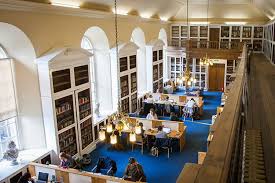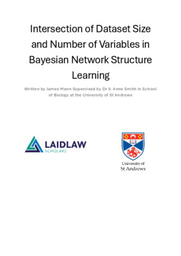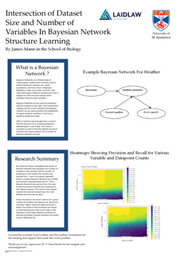Reflections on a summer in Bioinformatics

I came to this in a bit of a roundabout way; originally planning to work within the mathematics department on applications of graph theory. Unable to find a suitable supervisor, I had a look at the pre-defined projects. One of these was offered by my future Laidlaw supervisor Dr Anne Smith. The project was an application of Bayesian Networks (a type of computer model) to neuroscience data. The mention of networks piqued my interest as applications of graph theory involve networks. Over a couple of conversations, we realised my interests and skills were better suited to a simulation study on Bayesian Networks. In which computer simulations would be run to better understand the general behaviour of Bayesian Networks. Here the wonders of interdisciplinary work first appear. Simulation studies involving Bayesian Networks are not the most popular area of research. Understandably, most go straight to application in their field of interest. However, coming from an applied mathematics perspective examining the method itself, its strengths and weaknesses, is exactly what I was interested in.
June rolled around and the project went from a word document outline, to weekly meetings, and daily pilgrimages to the library. Once settled in, most days followed a similar rhythm. Wake up. Find a place to work for the day. Look at the results of a simulation run overnight. Code a new method of analysis or visualisation. Get a new simulation ready. Set it off, and wait. Simulations could take up to 20 hours which could be frustrating. However, I enjoyed the process as a whole and learned a lot. Not just about Bayesian Networks but more general skills like problem solving and programming.

During the research period I also got the opportunity to visit, and give a short talk to, a neuroscience group at the University of Aberdeen. I travelled with my supervisor, and fellow Laidlaw scholar Nicolas Etessami. Who has been working on a neuroscience application of Bayesian Networks using data from Aberdeen.2 After a quick tour of the neuroscience labs, I was tasked with explaining what a Bayesian Network is and how it works. Having to explain the inner workings of the model was a useful exercise. It strengthened my understanding and gave me a new perspective on the practical usage of my research. This new perspective guided the areas I focused on going forward, ensuring I answered the questions most relevant to other researchers. This linked up approach to research, with communication across disciplines, ensures that research can be built upon.
Going forward to ensure my research can be built upon. I am getting on with the Laidlaw research outputs and plan to adapt them into a publishable paper after the summer. If published not only have I gained valuable research experience, but the work I have done will be understood and built upon by others.
Footnotes:
[1] St James library in St Andrews: Image Link
[2] You can read about his project here: Link


Please sign in
If you are a registered user on Laidlaw Scholars Network, please sign in